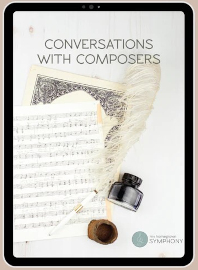Conversations with Composers explores the lives and works of 12 composers who represent different eras, countries, ethnic backgrounds, and musical styles. Twelve lessons—one per composer—are presented in this 76-page book, available in print and PDF formats. This course is ideal for a family, with activities geared for either younger learners (ages 4 to 8) or older learners (ages 8 to 12).
The lessons are divided into four musical eras: Baroque, Classical, Romantic, and 20th Century. Johann Sebastian Bach and Antonio Vivaldi represent the Baroque era. For the Classical era, students learn about Wolfgang Amadeus Mozart and Ludwig van Beethoven. Five composers are featured for the Romantic era: Pyotr Ilych Tchaikovsky, Clara Schumann, Frederic Chopin, Johann Strauss, and Camille Saint-Saëns. For the 20th Century, students learn about George Gershwin, Scott Joplin, and John Williams.
Lessons and Activities
Each lesson should take about 30 minutes, but you can spend more time with the recommended reading and listening options included for each lesson. The lessons begin with “Setting the Stage,” which consists of information or an activity designed to hook students’ interest.
Next, “Diving Deeper” presents information about the featured composer—his education, career, family, compositions, and other interesting details. Some lessons include a link to a video about the composer.
Two activities follow the background information, and some lessons include an extension activity that you might also use. Choose activities that suit your children. The activities for younger children involve games, drawing, coloring, painting with watercolors, listening, dancing, and creating a lightsaber and a scene with paper dolls. Older students do some of those activities plus sketching, online research, and completing graphic organizers with information gleaned from listening to musical pieces, A list of required resources at the beginning of each lesson tells what you will need, but most items will be art supplies and items found around the house.
Listening and reading suggestions are included. You will need to search YouTube®, Apple Music®, Spotify®, or other sites to locate the musical pieces for listening to each composer’s works. The recommended books (borrowed from the library or purchased) provide stories and broader background about each composer. A few are based on the composer’s musical compositions, such as the book Bea in The Nutcracker. Occasionally, there’s an optional video recommendation, such as Mr. Bach Comes to Call, that will need to be borrowed from the library or purchased.
Toward the end of the book, the coloring pages for each composer might help keep younger students engaged while listening or while older students do other activities.
QR codes and embedded website links are included within many sections of the lessons and in the appendix. In my opinion, it makes sense to purchase the PDF version of the course book so you can use these links. With the print book, you will be searching for websites, often without any guidance.
Summary
Those who have read my review of Prelude: An Introduction to Music for Children by the same author will note similarities between the two studies. Conversations with Composers seems best as a follow-up to Prelude. Note that the activities in Conversations with Composers for older students seem more purposeful than in Prelude. Like the Prelude lessons, Conversations with Composers’ broad perspective introduces children to a variety of musical styles, and they can spend more time listening and learning about those they find most interesting.









